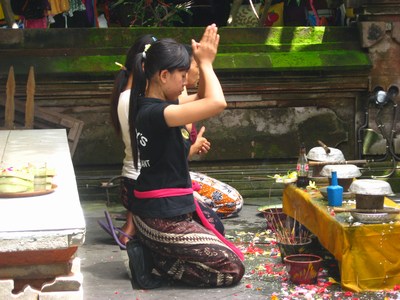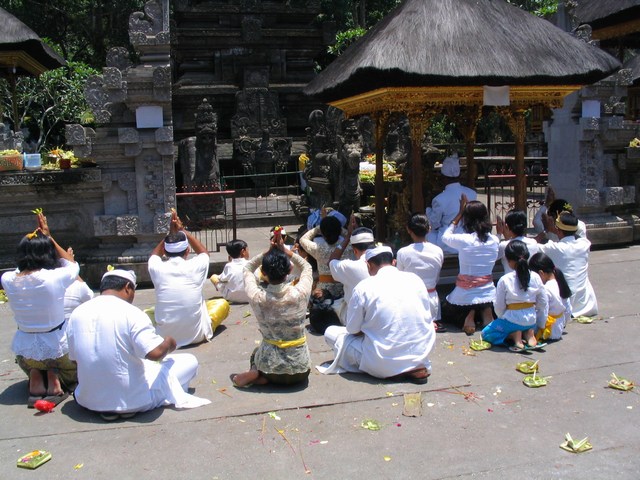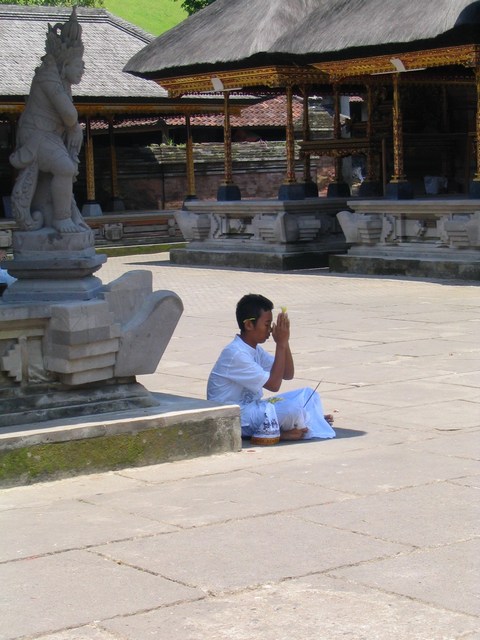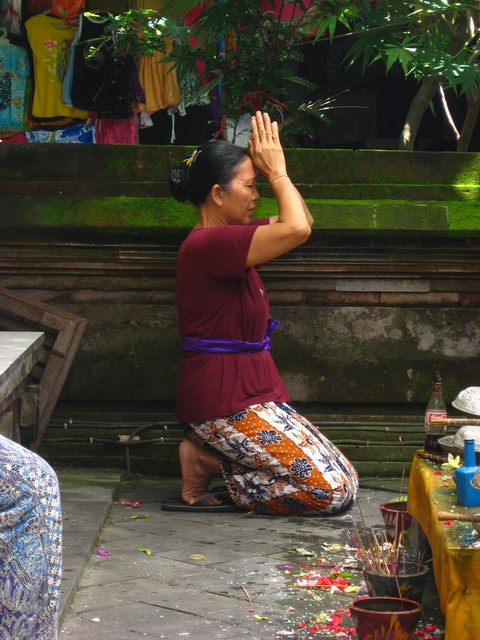Balinese at Prayer
 Every time I visit a temple and witness a ceremony or even see the morning prayers as Balinese lay floral offerings in the form of canang sari in front of shops or alongside the road, I am in awe at the spiritual beauty that is Balinese Hinduism. Religion plays a dominant role in the lives of the Balinese and is an integral part and includes every aspect from birth to death, life-cycle and daily rituals. Balinese Hinduism is animistic at core. It lacks the traditional Hindu emphasis on cycles of rebirth and reincarnation, but instead is concerned with a myriad of local and ancestral spirits. Visitors to Bali will be immediately aware of the strength of the local culture and its Hindu based religion. The Hindu religion did not take hold in Bali until the 9th century. By the 13th century, Hinduism in Bali was an amalgam of Hinduism, Balinese and Javanese indigenous systems. Local Balinese adapted to the new religious input by combining it with their old belief system. Balinese place great emphasis on dramatic and aesthetically satisfying acts of ritual propitiation of these spirits at temple sites scattered throughout villages and in the countryside. Every Balinese belongs to a temple by virtue of descent, residence, or some mystical revelation of affiliation.
Every time I visit a temple and witness a ceremony or even see the morning prayers as Balinese lay floral offerings in the form of canang sari in front of shops or alongside the road, I am in awe at the spiritual beauty that is Balinese Hinduism. Religion plays a dominant role in the lives of the Balinese and is an integral part and includes every aspect from birth to death, life-cycle and daily rituals. Balinese Hinduism is animistic at core. It lacks the traditional Hindu emphasis on cycles of rebirth and reincarnation, but instead is concerned with a myriad of local and ancestral spirits. Visitors to Bali will be immediately aware of the strength of the local culture and its Hindu based religion. The Hindu religion did not take hold in Bali until the 9th century. By the 13th century, Hinduism in Bali was an amalgam of Hinduism, Balinese and Javanese indigenous systems. Local Balinese adapted to the new religious input by combining it with their old belief system. Balinese place great emphasis on dramatic and aesthetically satisfying acts of ritual propitiation of these spirits at temple sites scattered throughout villages and in the countryside. Every Balinese belongs to a temple by virtue of descent, residence, or some mystical revelation of affiliation.
I will walk around or step over a canang sari wherever I go in Bali even though it is heavily trodden on or torn apart by animals searching for food. That’s just the way I am. If you visit a temple and there is a ceremony taking place, be discreet and avoid ‘getting in the way’ of the actual ceremony but instead sit quietly behind the worshippers and NEVER walk in front of them, or a high priest. So often I have seen tourists literally pushing cameras into the faces of priests just to get the perfect shot!



